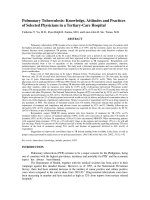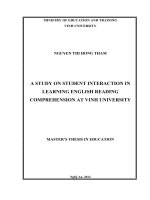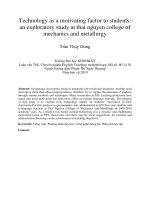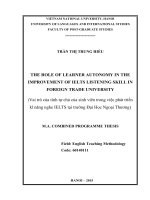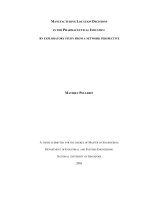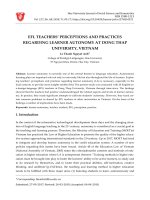Students’ perceptions and practices of learner autonomy in learning english reading comprehension – an exploratory study at a private university in bac ninh province
Bạn đang xem bản rút gọn của tài liệu. Xem và tải ngay bản đầy đủ của tài liệu tại đây (1000.74 KB, 109 trang )
VIETNAM NATIONAL UNIVERSITY, HANOI
UNIVERSITY OF LANGUAGES AND INTERNATIONAL STUDIES
FACULTY OF POSTGRADUATE STUDIES
*********************
NGUYỄN THỊ NGA
STUDENTS’ PERCEPTIONS AND PRACTICES OF LEARNER
AUTONOMY IN LEARNING ENGLISH READING
COMPREHENSION – AN EXPLORATORY STUDY AT A PRIVATE
UNIVERSITY IN BAC NINH PROVINCE
Nhận thức về tính tự chủ và thực tế thực hiện của sinh viên trong học tập
kỹ năng đọc hiểu tiếng Anh – Nghiên cứu tại một trường đại học dân lập
tỉnh Bắc Ninh
M.A. MAJOR PROGRAMME THESIS
Major: English Teaching Methodology
Code: 60140111
HANOI – 2017
VIETNAM NATIONAL UNIVERSITY, HANOI
UNIVERSITY OF LANGUAGES AND INTERNATIONAL STUDIES
FACULTY OF POSTGRADUATE STUDIES
*********************
NGUYỄN THỊ NGA
STUDENTS’ PERCEPTIONS AND PRACTICES OF LEARNER
AUTONOMY IN LEARNING ENGLISH READING
COMPREHENSION – AN EXPLORATORY STUDY AT A PRIVATE
UNIVERSITY IN BAC NINH PROVINCE
Nhận thức về tính tự chủ và thực tế thực hiện của sinh viên trong học tập
kỹ năng đọc hiểu tiếng Anh – Nghiên cứu tại một trường đại học dân lập
tỉnh Bắc Ninh
M.A. MAJOR PROGRAMME THESIS
Major: English Teaching Methodology
Code: 60140111
Supervisor: Dr. Dương Thi Nu
̣ ̣
HANOI – 2017
DECLARATION
I, the candidate, hereby certify that the thesis submitted for the Master of Art
degree at the University of Languages and International Studies is a presentation of
my own research and has not been previously submitted at any other universities for
any degrees. Wherever contributions of other researches are involved, every effort
is made to indicate this clearly, with due reference to the literature, and
acknowledgement of collaborative research and discussion. The work was done
under the guidance of Doctor Duong Thi Nu, at University of Languages and
International Studies.
Hanoi, 2017
Nguyễn Thi Nga
̣
i
ACKNOWLEDGEMENTS
I would like to express my gratitude to those who have contributed to the
completion of this dissertation.
First of all, I would like to send special thanks to my supervisor, Dr. Duong Thi
Nu, for the guidance and support that I have received from her in this research.
I am also deeply grateful for the support of the University, of which I was a
member of the teaching staff, and the enthusiastic participation of its students and
teachers in this research project. This study would not have been possible without
the valuable data they provided.
Last but not least, I owe my family wholehearted thanks for the everlasting
support and encouragement I received. I might not have gone that far on my
academic path without them.
ii
ABSTRACT
Learner autonomy has been considered as a desirable goal of learning and
teaching practice, especially in the field of language learning for it benefits learners
in numerous ways and enhances learners‟ chance for success in learning a language.
In Vietnam, a considerable amount of research projects has been devoted to
investigate different aspects of learner autonomy; however, few of them involve the
learner‟s perceptions of the concept. This study, therefore, is an attempt to explore
the extent to which the students in a provincial private university understand the
concept of learner autonomy and the extent to which their beliefs about the
construct are manifested in their learning of English reading comprehension.
With the nature of an exploratory research, the current study employed
questionnaire survey, learners‟ learning diaries, and focus group as the main data
collection methods. The findings from the study has revealed that the major
perception of learner autonomy in this context relates to „taking the initiative‟ in
learning, especially in self-study and the students are highly dependent on their
teachers in learning English reading comprehension. In addition, there is an
alignment between the students‟ understanding of the concept and the realization of
learner autonomy in their actual practice of English reading comprehension with
few autonomous activities performed.
iii
TABLE OF CONTENTS
DECLARATION ........................................................................................................ i
ACKNOWLEDGEMENTS ....................................................................................... ii
ABSTRACT .............................................................................................................. iii
TABLE OF CONTENTS .......................................................................................... iv
LIST OF ABBREVIATIONS .................................................................................. vii
LIST OF TABLES .................................................................................................. viii
LIST OF FIGURES................................................................................................... ix
PART A - INTRODUCTION ................................................................................1
1. Rationale for the study .........................................................................................1
2. Objectives and significance of the study .............................................................2
3. Scope and subjects of the study ...........................................................................3
4. Research methods ................................................................................................3
5. Structure of the report ..........................................................................................4
PART B – DEVELOPMENT ...................................................................................5
CHAPTER I - LITERATURE REVIEW ...............................................................5
1.1. Reading and Reading comprehension ..............................................................5
1.1.1. Definitions of reading and reading comprehension ...................................5
1.1.2. Models of reading comprehension .............................................................7
1.1.3. Reading comprehension strategies .............................................................8
1.1.4. Studies on improving reading comprehension in EFL contexts ................9
1.2. Learner Autonomy ..........................................................................................10
1.2.1. Definitions of Learner Autonomy ............................................................10
1.2.2. Types and Levels of autonomy ................................................................13
iv
1.2.3. Characteristics of autonomous learners....................................................15
1.2.4. Fostering LA in EFL/ESL contexts ..........................................................17
1.2.5. Obstacles to fostering LA in EFL contexts in Vietnam ...........................22
1.3. Learner Autonomy and Reading Comprehension ..........................................23
CHAPTER II - METHODOLOGY .......................................................................25
2.1. Research Objectives and Research Questions ................................................25
2.2. Research Design .............................................................................................25
2.2.1. Exploratory study using mixed methods ..................................................25
2.2.2. Rationale for using mixed methods research in the study........................33
2.2.3. Data collection methods ...........................................................................34
2.3. Description of the context ...............................................................................38
2.4. Participants......................................................................................................39
2.4.1. Students ....................................................................................................39
2.4.2. Teachers ....................................................................................................39
2.5. Procedures .......................................................................................................40
2.6. Data analysis ...................................................................................................40
CHAPTER III - DATA ANALYSIS AND FINDING DISCUSSION ................42
3.1. Quantitative data .............................................................................................42
3.1.1. Data management and coding ..................................................................42
3.1.2. Quantitative data analysis .........................................................................44
3.2. Qualitative data ...............................................................................................52
3.2.1. Data management and coding ..................................................................52
3.2.2. Qualitative data analysis ...........................................................................54
3.3. Discussion of the findings ..............................................................................67
v
PART C - CONCLUSION ...................................................................................71
1. Summary of the study ........................................................................................71
1.1. Research questions ......................................................................................71
1.2. Research Methods .......................................................................................71
1.3. Conclusions .................................................................................................71
2. Significance of the study ...................................................................................72
3. Limitations of the study .....................................................................................73
4. Implications for fostering LA ............................................................................73
5. Suggestions for further research projects ..........................................................74
REFERENCES ........................................................................................................75
APPENDIXES ........................................................................................................... I
APPENDIX A - PPLAQ .......................................................................................... I
APPENDIX B - SPLAQ ....................................................................................... IX
APPENDIX C ..................................................................................................... XIII
APPENDIX D ...................................................................................................... XV
APPENDIX E .................................................................................................... XVI
vi
LIST OF ABBREVIATIONS
LA: Learner Autonomy
ERC: English Reading Comprehension
ESL: English as a Second Language
EFL: English as a Foreign Language
PPLAQ: Perceptions and Practice of Learner Autonomy Questionnaire
SPLAQ: Students‟ Practice of Learner Autonomy Questionnaire
vii
LIST OF TABLES
Table 1: Coding table for the questionnaire ..............................................................42
Table 2: Student‟s perceptions of LA .......................................................................44
Table 3: Responsibilities of teachers and students for ERC learning and teaching
issues .........................................................................................................................48
Table 4: Students‟ practice of LA in English reading comprehension .....................50
Table 5: Emerging themes from qualitative data ......................................................54
viii
LIST OF FIGURES
Figure 1: A Heuristic for Thinking about Reading Comprehension........................... 6
Figure 2: Levels of processing in reading ................................................................... 7
Figure 3: Mixed methods design matrix .................................................................. 30
Figure 4: Sequential mixed methods design ............................................................ 31
ix
PART A - INTRODUCTION
1. Rationale for the study
In the context of Vietnam, while the development of science, technology,
ecomomy and other fields lags behind that of developed countries, the goverment has
been encouraging citizens to learn from other countries through science and technology
transfer. In that case, the ability of reading and comprehending materials written in
English is a key to knowledge acquisition for the fact that most knowledge today is
transferred in written form and available in English. In addition, reading has been
claimed as to be able to enhance the process of language acquisition and indirectly
improve other language skills (Funnel & Morgan, 1995; Rivers, 1988). Consequently,
more emphasis should be put on reading comprehension as a primary target of English
language learning among learners of English in Vietnam.
In recent years, the shift from teacher - centered to learner - centered approach in
Vietnam‟s educational system has put more emphasis on the role of learners in every
aspects of education including teaching methods and methodology, material
development and leaners‟ proficiency assessment. It can be said that understanding of
learner‟s characteristics is one of the keys to the success of our educational cause.
Within the credit-based educational system, which has been adopted recently, the
time alloted to classes is reduced and students are given more independence as well as
responsibility to their own learning. As a result, students with better autonomy will be
more likely to be successful in their learning. This is even much truer to English
language learning. First defined by Holec as the “ability to take charge of one‟s own
learning” in 1981, learner autonomy (LA) has gained much of interest of linguistic
researchers and practitioners as a promising field yielding positive findings to improve
the efficacy of English language learning among learners for nearly four decades to
date. There have been numerous research projects on LA exploring different aspects of
the concept such as language teachers‟ and learners‟ perceptions, teachers‟ beliefs,
1
teachers‟ practices, and ways and strategies to foster LA for language learners carried
out in different contexts.
Since the perception of autonomy changes according to different cultural and
educational conditions, before making any attempt to promote learner autonomy, we
should investigate students‟ readiness for autonomous learning. That is, we should shed
light on how ready students seem to take on the autonomous learning conditions and
opportunities (Chan, 2003). Promoting learner autonomy involves responsibility
change between teachers and learners, and researchers state that prior to this
responsibility change, we should investigate learners‟ readiness for this change by
investigating their perceptions of responsibility in the language learning process, and
their actual autonomous language learning practices (Cotterall 1995; Spratt, Humpreys,
& Chan, 2002; Chan, 2003). However, most studies of LA in Vietnamese context
focused on the perceptions of language teachers of the concept, their beliefs of LA as
well as methods to improve LA in classes (Hue, 2008; Le, 2009; Van, 2011; Thao,
2012; Tan, 2012; Nga, 2014). To the best knowledge of the researcher, there has been
no official work on the perceptions of the learners themselves of LA in ERC learning,
whereas the demand for better understanding of LA to improve the proficiency of
English language learners has never been low, both in general and specific contexts.
Therefore, the researcher is convinced that there is a need for an exploration into this
field, i.e. it is necessary to carry out a study on the learners‟ perceptions of LA in ERC
learning at the University.
2. Objectives and significance of the study
This study is carried out with the expectation of giving the English teaching staff
better understanding of students‟ perceptions and practices of LA in ERC learning.
Therefore, two major objectives have been set, which aim at exploring: (i) the extent to
which the students at the University perceive the concept of LA in learning ERC, and
2
(ii) the extent to which they practice LA in their ERC learning process. Accordingly,
two research questions have been formulated as follows.
RQ1. To what extent do students at the University perceive LA in English
reading comprehension learning?
RQ2. To what extent do the students practice LA in their English reading
comprehension learning process?
The findings from the study are expected to provide the University‟s English
teaching staff with better understanding of the students and their learning process so
that they might find and apply suitable and effective teaching methods and strategies to
improve the quality of teaching and learning English there as well as foster autonomy
among students of the University.
3. Scope and subjects of the study
For LA can be manifested in different aspects of the process of English language
learning including determining the objectives of the courses, choosing materials,
deciding learning methods and strategies, and assessing learning outcomes, the current
study investigates the perceptions of the students of LA in the abovementioned aspects
and the learners‟ realization of their perceptions in learning and practicing ERC.
The study involved both students and teachers of the University. In particular, 120
students of three cohorts participated in the questionnaire survey; ten of them were
asked to keep their learning diaries in 8 weeks and six of them were invited to talk in a
focus group. In addition, five teachers of English working at the University were also
invited to answer the questionnaire survey for teachers.
4. Research methods
In order to answer proposed research questions, a sequential mixed methods
approach is employed in the study. According to Creswell and Garrett (2008), a mixed
methods design is capable of providing an in-depth understanding of research problems
by combining quantitative and qualitative data, and explaining the quantitative results
3
in more detail with qualitative data. The data collection instruments to be used are
questionnaire, focus group and students‟ learning diaries in order to collect rich data to
comprehensively answer the research questions.
There are two phases in the process of data collection of this study. In the first
phase, 120 students participated in a questionnaire survey, which aims at finding out
their understanding of the LA concept and the manifestation of their understandings in
ERC learning process. In the second phase, ten students were asked to keep their
learning diaries for their own ERC practice. After that, six of them were invited to
share their ERC learning experiences in a focus group.
5. Structure of the report
In addition to the Introduction and Conclusion, the thesis is developed into three
focal sections preceded and followed by an introduction and a chapter summary
respectively.
Chapter I - Literature Review provides a theoretical background on the concepts
of learner autonomy, reading comprehension and relating issues.
Chapter II - Methodology describes the methodological approach for the research.
It details the research design with the choice of mixed methods approach and the
instruments for data collection process.
Chapter III – Data Analysis and Finding Discussion presents the analysis of
collected data and important results yielded from the two-phase research paradigm.
Finally, the Appendixes part provides samples of data collected with different
apparatuses and other important data which are not reported in the main part of the
thesis.
4
PART B – DEVELOPMENT
CHAPTER I - LITERATURE REVIEW
In this chapter, the definitions of basic concepts including reading and reading
comprehension, reading strategies, and LA as well as relevant issues will be reviewed
to form a sound theoretical background for the study.
1.1. Reading and Reading comprehension
1.1.1. Definitions of reading and reading comprehension
Undoubtedly, reading has been of much interest of linguistic researchers with the
presence of numerous research projects on reading comprehension as well as strategies
to improve learners‟ reading comprehension ability in different contexts. Nevertheless,
it is still worthy reviewing what have been learned about reading and reading
comprehension.
Discussing reading and reading comprehension, Alderson and Bachman (2000)
mark a contrast between the process of reading and the result of that process (as cited
in Tabataba‟ian & Zabihi, 2011). While the former refers to the interaction of the
reader and the text, the latter is the meaning of a text that the reader gets as the product
of the reading process. In their views, reading is not a static but a dynamic process. In
other words, reading can be seen as an interactive process where readers and writers
depend on one another to transmit messages through texts.
As Brown (2001) puts it, a text does not carry meaning by itself. Instead, while
reading a text, the readers bring their own information, knowledge, emotions and
experiences to the printed words to make it meaningful. He adds that there are two
categories of schemata: content schema and formal schema. Content schema refers to
our knowledge of people, the world, culture and the universe, whereas formal schema
is our knowledge of the structure of texts. In reading process, each schema exerts a
certain influence on the readers‟ comprehension of given texts.
5
Grellet (1981: 3) views reading comprehension as the process of extracting the
required information from a written text as efficient as possible, while Kirby (2007: 1)
has a more general definition of reading comprehension, which is understood as “the
process by which we understand the texts we read”. According to Kirby (2007),
reading occurs at different levels ranging from words to themes. He also adds that
reading comprehension needs intentional instructions and is more challenging than
listening comprehension, which develops naturally with minimal deliberate
intervention.
In more detail, Snow (2002: 11) defines reading comprehension as “the process of
simultaneously extracting and constructing meaning through interaction and
involvement with written language”. She believes that the process of comprehension
changes over time as the readers mature and develop cognitively, gain increasing
experience with more challenging texts, and
benefit
from
Futhermore,
comprehension
instructions
she
claims
process
(2002:
that
13).
reading
involves
three
elements including the reader, who is doing
the
comprehending,
the
text
to
be
comprehended, and the activity whose part is
comprehension. All three elements interact
under the impact of socialcultural context.
Regardless of certain differences, all
Figure 1: A Heuristic for Thinking
definitions
of
reading
comprehension
about Reading Comprehension (Adapted
mentioned above share the core idea that
from Snow, 2002)
reading comprehension involves the processes
of extracting, analyzing and understanding the information transmitted through written
words. Nevertheless, the definition given by Snow (2002), which defines reading
6
comprehension as “the process of simultaneously extracting and constructing meaning
through interaction and involvement with written language” seems to be the most
comprehensive for not only clarifying the nature of reading comprehension but also
detailing the components of the reading process. Therefore, the current study will adopt
Snow‟s (2002) definition as one of the main contructs.
1.1.2. Models of reading comprehension
Basically, there are three models of reading comprehension including bottom-up,
top-down, and interactive (Brown, 2001; Ghonsooly, 1997; McCormick , 1988).
Bottom-up reading model is the process starting from the text. It assumes that by
working on a combination of different
aspects of the written text, the learner can
increase their ability to comprehend it. The
key idea of the model is decoding elements
of the text from letters to words, phrases,
and then to sentences. The meaning will be
derived in a linear manner. Bottom-up
reading model is believed to be a passive
process where readers rely too much on
Figure 2: Levels of processing in reading
specific elements of the text to get its
meaning (Celce-Murcia & Olshtain, 2000; Van Dijk & Kintsch, 1983).
Top-down reading model is the reverse of the bottom-up one, which starts from
the reader. It assumes that the learner brings to the text certain knowledge of the world,
of the text‟s structure, and of the language to get its meaning. This knowledge is likely
to be useful in understanding a text, but it often needs to be activated with such
activities as discussions, questionnaires, quizzes, brainstorms, and vocabularyanticipation.
7
However, in practical reading activities, most people would be likely to find
themselves using a combination of the two approaches, switching from one to another
depending on the text and the information required. This is the third model of reading,
interactive reading model (Alderson & Bachman, 2000; Brown, 2001). The model
combines both bottom-up and top-down aspects of reading to build the meaning.
Readers use both knowledge of word structure and background knowledge to interpret
the texts they are reading. The most evident benefit of this model is the opportunity for
the differentiation that it provides students. Students are not required to fit into a preset
approach or have identical skill sets to decode and interpret texts. Instead, they are
encouraged to use their own strengths to understand the text and get new information.
This model allows the reader to bring his own background knowledge to reading and to
interact with others to build meaning from the text. Interactive reading model is also
currently accepted as the most comprehensive description of the reading process
(Anderson, 1999).
1.1.3. Reading comprehension strategies
In reading process, in order to comprehend the meaning of the text, every reader
would employ certain strategies to process the written words. Reading strategies are
defined as mental operations relating to how readers perceive a task, what textual cues
they pay attention to, how they make sense of what they read, and what they do when
they do not understand (Block, 1986). Reading strategies help students to process the
text actively, to monitor their comprehension and to relate what they are reading to
their own knowledge and to other parts of the text. Strategies, therefore, are important
in reading, and particularly useful when the text is long and/or complex, and the
reader has many options of where and what to attend. There are various strategies
suggested to improve reading comprehension of readers proven with research evidence.
Following are the most common mentioned by many researchers (NRP, 2000;
McNamara, 2004, 2007).
8
1. Comprehension monitoring in which the reader learns how to be aware or
conscious of his or her understanding during reading and learns procedures
to effectively deal with problems arising in understanding the text.
2. Previewing identifies the topic and the level of readers‟ familiarity with the
topic.
3. Identifying paragraph structure to see the pattern of the paragraph, whether
it is deductive or not. In other words, this strategy suggests that the readers
should locate the position of the topic sentence first to get the main idea of
the whole paragraph.
4. Using background knowledge to relate new idea presented and what is
already known about it by asking questions about the topic.
5. Predicting what types of information could be provided in the text.
6. Guessing the meaning of new words from the context.
7. Inferring information from what is written.
8. Question answering in which the reader answers questions posed by the
teacher and is given feedback on the correctness.
9. Summarizing in which the reader attempts to identify and write the main or
most important ideas that integrate or unite the other ideas or meanings of
the text in a coherent way.
1.1.4. Studies on improving reading comprehension in EFL contexts
The essential position of reading comprehension in English as a Foreign Language
(EFL) contexts has turned improving reading comprehension ability of EFL learners to
one of the most common researched topics among linguists and language practitioners.
Various research projects have been done to introduce methods to enhance the EFL
learners‟ ability of reading comprehension as well as to verify or falsify effects of
introduced methods in certain EFL settings such as visualization (Erfani & Iranmehr,
2011), summarization strategy (Zafarani & Kabgani, 2014), comprehension strategy
9
instruction (Fan, 2010). Generally, the findings of those research projects show
positive effects of the introduced methods. However, certain modifications are
suggested to suit specific contexts and generate the most efficient outcomes.
In addition to the studies of methods and strategies to enhance reading
comprehension of EFL learners, there are numerous research projects exploring the
relationship between reading comprehension and other components of reading process
such as materials, learners and teachers. Studies on the relationship between reading
comprehension and phonological, morphological awareness (Abdul Gafoor & Remia,
2013), reading comprehension performance and strategy use (Dabaghi & Akvan,
2014), influences of stimulating tasks on reading comprehension (Guthrie, Wigfield,
Humenick, Perencevich, Taboada, & Barbosa, 2006) have given insightful
understanding of reading comprehension and affective factors that need to be
considered in teaching and learning reading comprehension in EFL contexts.
Reading materials is another focused topic for researchers and practitioners who
want to improve EFL learners‟ reading comprehension ability through materials.
Various types of reading materials have been suggested such as culture-based (Utami,
Nitiashi, & Artini, 2014), genre-based, authentic materials, and Internet-based and
Science Research Assosiates reading materials, etc. Each type has its own strengths as
well as weaknesses in practical use; therefore, in specific contexts, they all need to be
modified suitably.
It can be seen that language researchers and practitioners have been making great
efforts to contribute to the improvement of language leaners‟s reading ability,
especially in EFL contexts.
1.2. Learner Autonomy
1.2.1. Definitions of Learner Autonomy
As Learner Autonomy (LA) has become part of the mainstream of research and
pratice within the field of language education, much has been talked about the concept
10
in numerous research projects on LA as a consequence. At the first time of its
appearance, LA was defined as the “ability to take charge of one‟s own learning”
(Holec, 1981: 3). He then elaborates on his definition as the responsibility of a learner
for all the decisions concerning every aspect of the management and organization at
different stages of one‟s own learning including:
- determining the objectives;
- defining the contents and progressions;
- selecting the methods and techniques to be used;
- monitoring the procedure of acquisition properly speaking (rhythm, time,
place, etc.)
- evaluating what has been acquired.
This definition is partly agreed among various other researchers after Holec in latter
research projects on LA (Dickinson, 1995; Cotterall, 1995; Littlewood, 1999; Benson,
2001; Little, 2007). However, some modifications have been made with “capacity”
replacing “ability” and “take responsibility for” or “take control of” replacing “take
charge of” by Holec himself and some other researchers (Benson, 2001; Dickinson,
1987). Benson (2001: 49), nevertheless, comments that though Holec‟s definition of
autonomy “adequately covers the main areas of the learning process in which one
might expect the autonomous learner to exercise control”, it “describes the decisionmaking abilities involved in autonomous learning in largely technical terms” and does
not explicitly discuss cognitive factors involved in the development of autonomy. He,
then adds the argument of Little (1991) that “autonomy is a capacity – for detachment,
critical reflection, decision making, and independent action” and “the learner will
develop a particular kind of psychological relation to the process and content of his
learning”. The capacity for autonomy will be displayed both in the way the learner
learns and in the way he or she transfers what has been learned to wider contexts”
(Little, 1991, cited in Benson, 2001:49). Moreover, he argues that both Holec‟s and
11
Little‟s definitions did not give enough attention to “the third vital element in
autonomous learning: that the content of learning should be freely determined by the
learners”, which has “a situational aspect” and “a social aspect”. He asserts that control
[over learning process] is a question of collective decision-making rather than
individual choice” (Benson, 1996: 33, cited in Benson (2001:49). For that reason, it is
necessary for autonomous learners to possess particular interaction capacities to work
with others in the learning process (Benson, 2001: 49).
Benson (2001:47) defines the concept of LA in language learning as the capacity of
people “taking more control over the purposes for which they learn languages and that
ways in which they learn them”. Autonomy, therefore, involves both leaners‟ abilities
and attitudes which can develop to various degrees. As Benson (2001: 47) views it, LA
is a “multidimensional capacity”, which may “take different forms for different
individuals, and even for the same individual in different contexts or at different
times”. In other words, LA can be manifested in different ways and to different degrees
depending on the language learners themselves in specific contexts and at certain
times. With a belief that efforts to cover every potential aspect of control over learning
may result in a lengthy definition of LA in practical use, Benson (2001) suggests that it
is acceptable to employ the simple definition of LA as “the capacity to take control of
one‟s learning as one that establishes a space in which differences of emphasis can coexist” (Benson, 2001:50). However, he emphasises that it is necessary for an adequate
description of autonomy in language learning to recognise three important levels of
control that autonomous learners may exercise: learning management, cognitive
processes and learning content.
Specifically, the control over learning manegement involves the managment of the
learners‟s behaviours in planning, organizing and evaluating their own learning.
Benson (2001) believes that this level is most directly observable among levels of
autonomy. The control over cognitive processes in learning is concerned with the
12
learners‟ attention, reflection, and metacognitive knowledge. Little (1991) observes
that the autonomous learner will “develop a particular kind of psychological relation to
the process and contrent of his learning” (cited in Benson, 2001: 98). This will help to
distinguish a real autonomous learner and the learn with “the mask of autonomy”
(Breen and Mann, 1997, cited in Benson, 2001: 98). The control over learning content
involves the social domain of learning when it requires the learner to interact with
other learners to determine and implement their own learning goals and tasks or with
teachers and possible higher authorities to negotiate the curriculum. As a consequence,
it requires learners to develop their own capacity to participate in social interactions
concerning their learning. It also requires that teachers and education authorities create
favourable situational contexts to support and encourage the independence of learning.
Though the definitions given by different researchers might vary slightly, they seem
to share the focal points featuring LA that LA requires learners themselves to take the
responsibility for their own learning both during and after the period of formal
education and “the responsibility” of learner involves their participation in decisionmaking processes of learning objectives, learning methods, learning content, and
progress assessment, which are traditionally believed to be the responsibility of
teachers.
Considering all the abovementioned points of view, LA, in this current study, is
understood as the capacity of language learners themselves to control their own
learning over different dimensions of the learning process including objectives,
methods, content, and assessment. These are also used as a basis to develop questions
in the questionnaire survey intended to explore the respondents‟ perceptions of LA.
1.2.2. Types and Levels of autonomy
Littlewood (1999) proposes two types of autonomy namely “proactive autonomy”
and “reactive autonomy”. The former is the form of autonomy in which learners are
able to “take charge of their own learning” and “establish a personal agenda” by
13
determining learning objectives, selecting learning methods and techniques and
evaluating learning progress. The latter one can be considered to be a “premilinary step
towards the former or a goal on its own right”. In Littlewood's explanation, this form of
autonomy “does not create its own directions but, once a direction has been initiated,
enables learners to organize their resources autonomously in order to reach their goal”
(Littlewood, 1999: 76). He also believes that although many researchers recognize only
what he called “proactive autonomy”, “reactive autonomy” is worthy being attended in
talking about education. The distinction Littlewood makes between the two forms of
autonomy and what he talks about “reactive autonomy” imply that in order to obtain
LA in language learning and teaching, it is not necessary for learners to count on their
own only. Instead, support and guidance from teachers or supervisors are promisingly
useful resources of which they can take advantage. In other words, in education, if
teachers would like to foster LA among their learners, they can make changes by
giving support and guidance to set a suitable direction for their learners.
LA can be manifested in different forms and to different levels. According to
Nunan (1997: 195), there are five levels of autonomy realized in “learner action”
including “awareness”, “involvement”, “intervention”, “creation”, and “transcedence”.
These levels involve dimensions of “content” and “process” and could inform the
sequencing of learner development materials; however, they are criticized for
“overlaps” and the possibility that “learners will move back and forth among levels”
(Hsu, 2005: 99).
Another model introduced by Littlewood (1997: 81) with three stages involving
dimensions of language acquisition, learning approach, and personal development.
These dimensions reflect an individual‟s autonomy as a communicator, a learner and a
person in corresponding contexts of language acquisition, classroom organization, and
a broader one. Respectively, autonomy involves “an ability to operate independently
with the language and use it to communicate personal meanings in real, unpredictable
14
